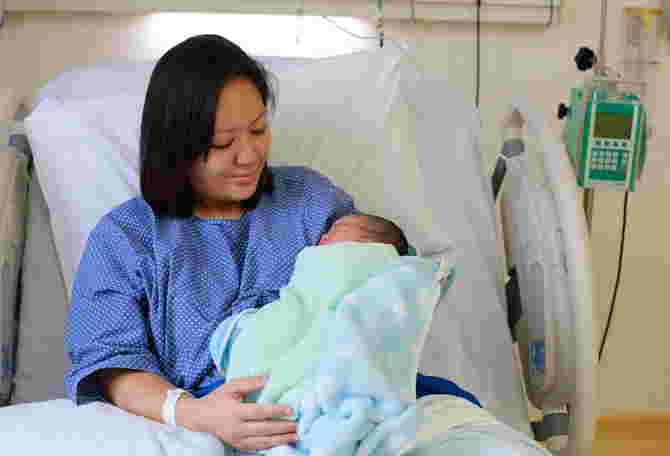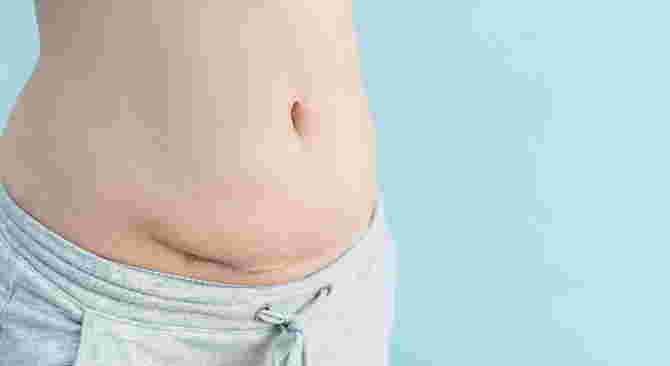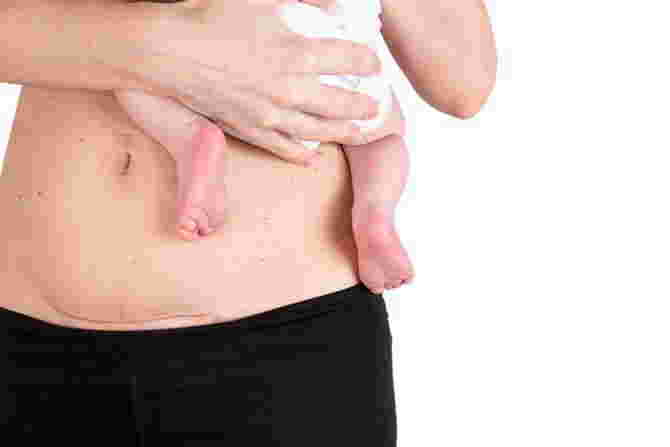What to Expect After A C-Section And Speed Up Scar Healing

After having a baby by c-section, your body will need time to recover -- this includes the c-section scar.
As a new mum, your ultimate goal is for your little angel to arrive in the world safely. As long as they are healthy and happy, that’s all we ask for. So, if the doctor delivering your baby recommends Caesarean-section surgery, we shouldn’t go against the doctor’s advice.
Many mums often fear going through a c-section surgery because it results in a c-section scar.
But according to Obstetrician and Gynecologist, Universiti Kebangsaan Malaysia Medical Center (PPUKM), Professor Dr Nur Azurah Abdul Ghani, the rate of mothers giving birth by surgery nationwide is at 30 per cent in every hospital1.
The procedure is common and life-saving for both mother and baby. So that means 30 per cent of mums giving birth now will end up with a c-section scar.
Naturally, we will do anything to ensure our c-section scar heals well, leaving only a faint line above the pubic hairline that can be easily covered by underwear.
However, if mums do not know how to care for their scars properly, it might end up forming keloids or cause other complications.
So we’re here to give you some useful tips in c-section scar care.
What Is a Caesarean Section?

Credit: iStock
Before we dive into how to heal your c-section scar, one myth that we need to bust is that caesarean surgery is easier than vaginal surgery. Many view this as an “easy” way out.
Caesarean section surgery is major abdominal surgery. It is a surgical delivery of a baby that involves one incision in the mother’s abdomen and another in the uterus2.
Reasons for a caesarean delivery including:
- The baby has developmental conditions that could risk her life
- The baby’s head is too big for vaginal delivery
- Breech birth – baby’s feet out first instead of the head
- Mother with health conditions such as high blood pressure
- Placenta previa
- Baby has lower oxygen level due to infection or lung problems
- Umbilical cord prolapse
- Transverse labour position
- Stalled labour
- Other complication advised by the medical practitioners
As with any surgery, that means there will be a longer recovery period ahead for mums.
What to Expect After Caesarean Delivery

Credit: iStock
Depending on how well your surgery went, some doctors will advise you to stay in the hospital for the next two or three days. In fact, many guides suggest that women who went through caesarean delivery will need between four to six weeks to recover.
However, some studies have discovered that 60 per cent of women have some pain at the incision site 24 weeks after delivery3.
That means mums have to really take care of their bodies after going through a c-section surgery.
Immediately after surgery
After your delivery, you will be moved to a post-operative area where you will remain under observation.
Here the hospital staff and medical practitioner monitors everything from bleeding, blood pressure and your body temperature. You will remain on an IV where this allows for an adjusted level of painkillers to be delivered into your bloodstream while the anaesthesia wears off4.
The first 24 hours
Just like normal delivery, new mothers will start to learn how to breastfeed, change the diapers, burp their babies as well as adjust to their new life in parenthood.
The nurses might massage your uterus to encourage it to contract and shrink to normal size.
You will also be encouraged to start moving slowly as it will help to speed up your C-section healing and to reduce the risk of getting a blood clot.
In the first 24 hours, it is also common to feel pain around the incision area. The medical practitioner will keep a close eye on your incision, making sure there is no sign of infection.
Two days after surgery5
Other than walking, you are also allowed to take a shower as doing so helps to reduce the risk of infection.
Your bandage will be removed about 24 hours after surgery. However, do not scrub your incision. Just let the water run over it. Once you’re done, dry the area by gently patting it with a towel.
You will still have to wear a pad for bleeding. The discharge is called lochia, which is a combination of leftover blood, mucus and uterine tissue. You are also encouraged to start eating solid foods.
The first week

Credit: iStock
The risk of infection will be at its peak during this time. You are advised to keep a lookout for haemorrhage as it is most likely to occur during this time.
Your wound will feel sore for the next one or two weeks as the surrounding muscles are still weak6.
Slow and steady wins the race here as the journey of healing is a long one. Doctors will give you advice like not to exercise or do any heavy lifting during this time and it is very important to listen to your doctor’s advice.
In some cases, you might have to go back to the doctor to check on the wound within the first week but in most cases, the doctor will use dissolvable stitches which will disappear on its own, reducing the need for you to leave the house to see them for a follow-up.
The second week
You will be asked to see your doctor once again to examine the incision. At this point, if the incision starts to show excessive swelling, redness, infection or you are running a fever higher than 38 celsius, you must immediately call your doctor.
Keep in mind that you might still look like you’re pregnant at this stage, although your uterus is slowly shrinking back to its original size. At this stage, your caesar wound would have become dried and closed, thus you can begin to care for your scar.
Week 4 to 6
Listen to your body and do not compare your recovery journey with anyone else. You will notice that you have started to move swiftly at that point and your bleeding might stop completely.
If you still feel tired or slow, take your time and rest as much as you can. By the end of week six, you will be fully recovered and you can even start to have intercourse with your spouse.
Your incision should be perfectly healed at this point, and you can finally resume your normal activities.
How to Speed Up C-Section Scar Healing

Credit: iStock
As ready as you are to run the world again, taking care of yourself after childbirth should be one of your top priorities (alongside the growth of your baby, of course).
So here are some useful tips you can use to speed up the healing of your c-section:
- Keep the wound clean and wear loose tops and pants that do not chafe your stomach.
- Avoid carrying, holding and lifting heavy items – except for your baby. When nursing, place the baby on a pillow over your incision to protect the area
- Walk every day to prevent blood clots and constipation.
- Drink enough water and eat a well-balanced diet.
- Keep your incision area dry and clean.
- Use scar reduction products to lighten, soften and flatten the c-section scar.
Important C-Section Scar Healing Tip
Mummies, you must remember that there is little you can do to make the scar disappear completely. But there are things you can do to make the scar healing process better.
One of the things that we have mentioned, using scar reduction products, can certainly help in lightening and flattening the c-section scar.
Dermatix UltraⓇ is an Asian Parent recommendation product clinically proven for c-section scar healing. It is a gentle, gel-based formulation with unique CPX silicone technology and vitamin C ester to lighten, soften and flatten surgical scars.

CPX, which stands for Cyclopentasiloxane, plays the role of improving the appearance of the c-section scar, leaving the skin with a smooth silky feel upon application. Meanwhile, Vitamin C Ester helps to enhance the lightening of the scars (similarly to how Vitamin C products for our face also helps to lighten acne scars). This unique Vitamin C ester is also pH neutral, which means it does not cause irritation to the skin, unlike conventional Vitamin C in acidic format.
The combination of these two key ingredients makes it ideal to use on hypertrophic scars and keloids.
Ideally, you should start scar treatment with Dermatix UltraⓇ as early as 10-14 days after c-section surgery or once the surgical wound has dried and closed, to achieve the most optimal results.
Dermatix UltraⓇ also supports your body’s natural recovery process by protecting your scar and regulating collagen production to minimise scar formation. It has an over 85 per cent success rate in softening and diminishing hypertrophic and keloid scars7,8.

The best part about it is that it is suitable for daily use. For best results, apply Dermatix Ultra twice daily for 2-3 months for normal scars; 6 months or more for deeper and longer scars such as surgical scars, or until you experience the full benefit of scar treatment.
So take good care of your c-section scar. Avoid applying products that have not been recommended, and treat your c-section scar healing process with tender loving care by purchasing your tube of Dermatix Ultra here today!
Reference:
- (September 2, 2020). Bersalin secara pembedahan. Retrieved June 30, 2021, from www.hmetro.com.my/WM/2020/09/616327/bersalin-secara-pembedahan
- (n.d). C-Section (Cesarean Section). Retrieved 30 June, 2021, from www.healthline.com/health/c-section
- (n.d.). Cesarean section. Retrieved 30 June, 2021, from www.ncbi.nlm.nih.gov/books/NBK115312/
- (n.d). C-Section (Cesarean Section). Retrieved 30 June, 2021, from www.healthline.com/health/c-section
-
(n.d.). C-Section Recovery Timeline: A Six-Week Guide for New Parents. Retrieved 30 June, 2021, from www.parents.com/pregnancy/giving-birth/cesarean/your-c-section-recovery-timeline-and-tips/
- (n.d.). Recovering at home after a c-section. Retrieved 30 June 2021, from www.tommys.org/pregnancy-information/giving-birth/caesarean-section/recovering-home-after-c-section
- Fulton JE. Silicone gel sheeting for the prevention and management of evolving hypertrophic and keloid scars. Dermatol Surg 1995;21:947-951
- Mercer NSG. Silicone gel in the treatment of keloid scars. Br J Plastic Surg. 1989;42:83-87
Disclaimer: You are not allowed to share this article on any other website or on Facebook without providing proper credit and the original article link on theAsianparent Malaysia website
Read more: Helpful Breastfeeding Basic Tips for the New Mum Within the First 6 Months
Read more: This mum’s amazing 32 kg weight loss transformation will stun you!
Read more: Lochia – postpartum bleeding